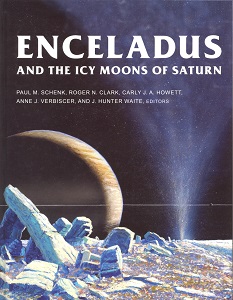Long gone are the days when it was difficult for book authors to fill more than a chapter on each of the outer planets; now they can fill a 300-page book with details of “Saturn’s icy moons”.
This academic volume is a tour de force produced by five editors and no less than 84 contributing authors. The multi-author papers it contains are grouped into four main sections: the first on the geophysics, geology and geochemistry of Enceladus, the second on its famous plumes, the third on the other icy moons and the fourth on astrobiology and possible exploration of Enceladus.
Why is Enceladus worthy of so much attention? Linda Spilker, Cassini Project Scientist at JPL, sums it up well: “With organic molecules, and tidal heating producing a global subsurface liquid water ocean and a possible hydrothermal vent system on the seafloor, Enceladus’ ocean could harbor the ingredients for life”.
Although the book’s charts, tables and diagrams (along with some equations) strongly suggest an academic audience, any educated reader intent on digging the detail on Enceladus will find a wealth of interesting information in this volume. It is illustrated predominantly with black and white photos and line diagrams but also benefits from a 40-page colour section. It is, of course, profuse with references and has a decent index.
Is there life on Enceladus? The submarine-type probes proposed for future missions to the moon may be key in providing an answer; and the results from those missions would doubtless fill a similar volume.










